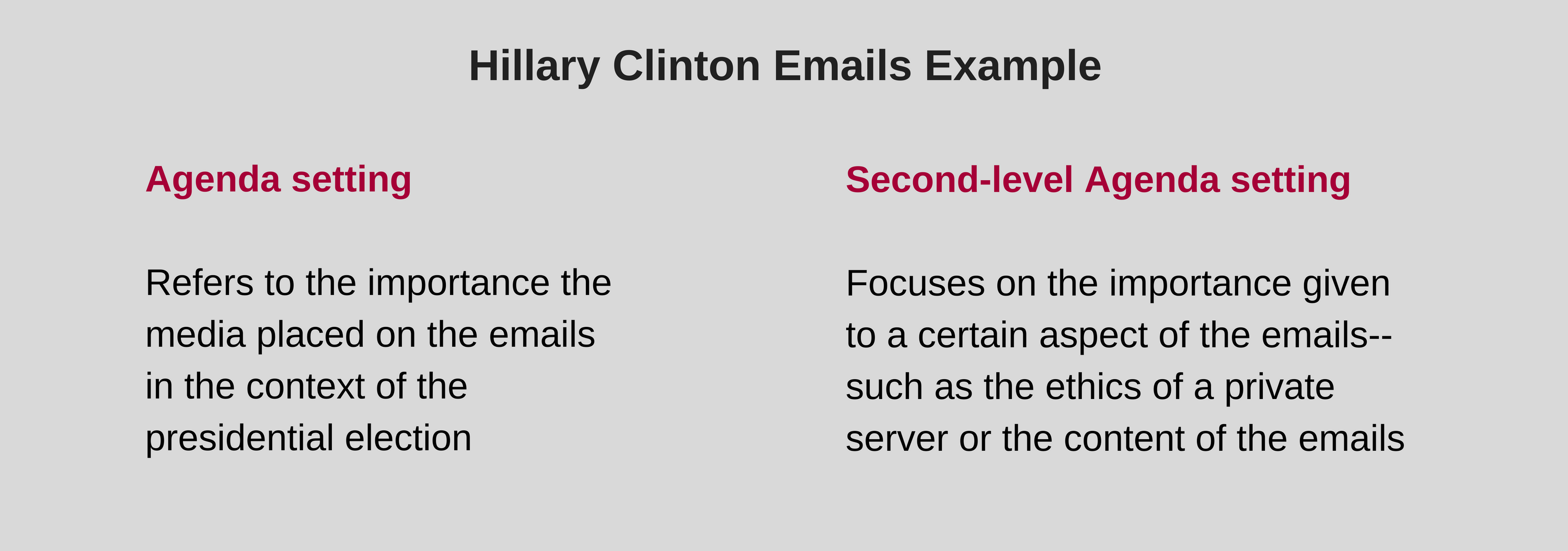Agenda Setting Theory Definition
That is if a news item is covered frequently and prominently the audience will regard the issue as more important. Agenda-setting theorys main postulate is salience transfer.

Lesson 1 Media S Agenda Setting Role
This is to say that the more attention the mainstream media gives to certain events the more likely the public is to consider the issue important.

. Agenda-Setting Theory is known as a theory that holds intense media attention increases the importance of certain topics issues and individuals. The media gives repeated attention to an issue causing an increase in the public salience of that issue. Agenda setting is the transfer of salience from the media to the public meaning the media influences how important the public finds an issue Yioutas Segvic 2003.
In other words when certain topics are reported in the media then the importance of those topics increase due to that certain individual. This study found a correlation between issues that voters believed were important and issues that the media gave prominence to. Agenda-setting theory describes the ability of the news media to influence the salience of topics on the public agenda 1 Essentially the theory states that the more salient a news issue is - in terms of frequency and prominence of coverage - the more important news audiences will.
Thus the level of mass media tweaks in the broadcast cannot be quantified to study the influence. Agenda-setting is where the media only ask a limited range of questions about a topic thus limiting the number of perspectives or angles from which an issue is explored. Agenda-setting is crucial theory that has been often used in political communication studies which is basically argues the important influential role of the media into the public agenda.
Agenda-setting theory focused initially on the objects defining the media and public agendas. Agenda-setting theory discusses the medias influence on society by controlling what to think about and how to think about it. It does this not so much by telling people what to think but rather what to think about.
The term object is used here with the same meaning as the term attitude object in social psychology. At the core of the theory is the notion that mass media forms the primary interface. Agenda setting is a theory of mass communication that describes the way in which the mass media interacts with and affects the public it targets.
Agenda setting is a social science theory. Agenda Setting Theory Explained with Applications Marketing91 One of the first criticisms is that the level of agenda-setting of any piece of information is difficult to measure. Agenda-setting theory refers to how the medias news coverage determines which issues become the focus of public attention.
In terms of what stories to consider newsworthy and how much prominence and space to give them. The theory also suggests that media has a great influence to their audience by instilling what they should think instead of what they think. Agenda-setting theory states that the news media have a large influence on audiences.
This happens by emphasising certain news repeatedly. This transference is known as the first-level of agenda setting. The agenda-setting theory introduced by the Max McCombs and Donald Shaw in 1968 in order to express the presidential election.
In agenda setting the objects most frequently studied are public issues and political figures. An academic study describes how media influence viewers through audience-relevant agenda establishes news prevalence according to a hierarchy and describes how to change programming. Agenda setting theory is defined as the power of news media whereby mass media set an agenda which will influences the public which is called as public agenda by highlighting the issue frequently in media.
The media yields authority over the truth behind the information by showing it selectively and not comprehensively. Salience transfer is the ability of the news media to transfer issues of importance from their news media. It also attempts to make predictions.
Setting an agenda helps to direct public spending toward the important topics of a public agenda by the media being able to influence it. Therefore the main effect of media in agenda setting is telling people not what to think but what to think of. The Agenda Setting Function Theory was developed by Maxwell McCombs and Donald Shaw in 1972 as a result of their study of North Carolina voters during the 1968 presidential election campaign.
It is a concept mainly associated with Marxism and it is one of the main ways in which the media maintain ideological control according to Marxist analysis. The theory has two fundamental assumptions. The agenda-setting theory states that the mainstream media sets the agenda of public discourse.

The Agenda Setting Function Theory Vce Media Vels Media Media Arts Digital Literacy Media Education Filmmaking Digital Literacy Agenda Theories

Agenda Setting Theory Of The Media Proprofs Quiz

Agenda Setting Theory Of The Media Proprofs Quiz

Agenda Setting Theory Of The Media Proprofs Quiz

Agenda Setting Theory Politics Examples What Is Agenda Setting Video Lesson Transcript Study Com
0 Response to "Agenda Setting Theory Definition"
Post a Comment